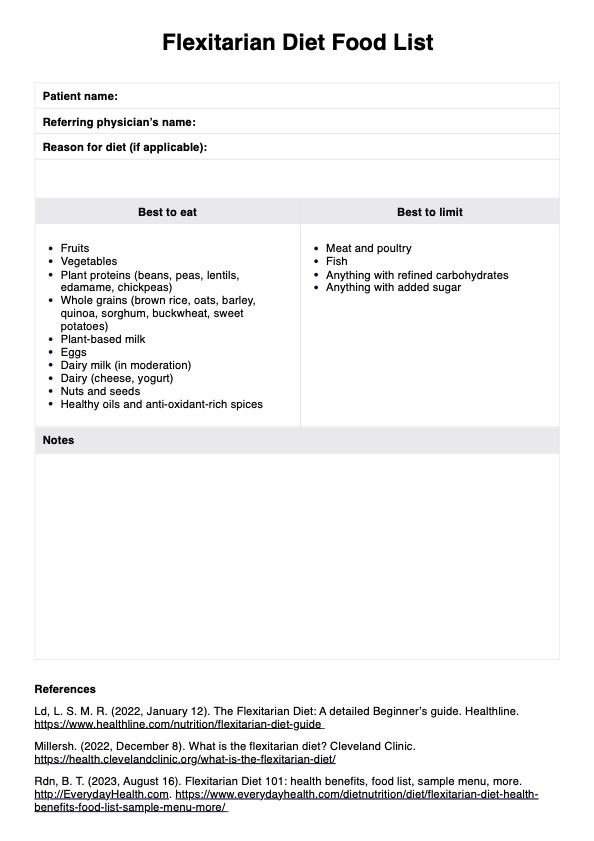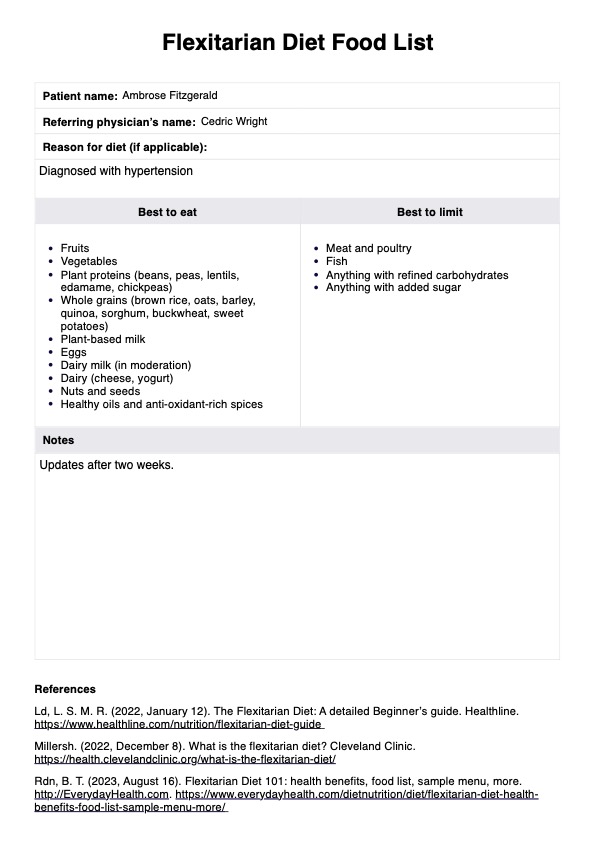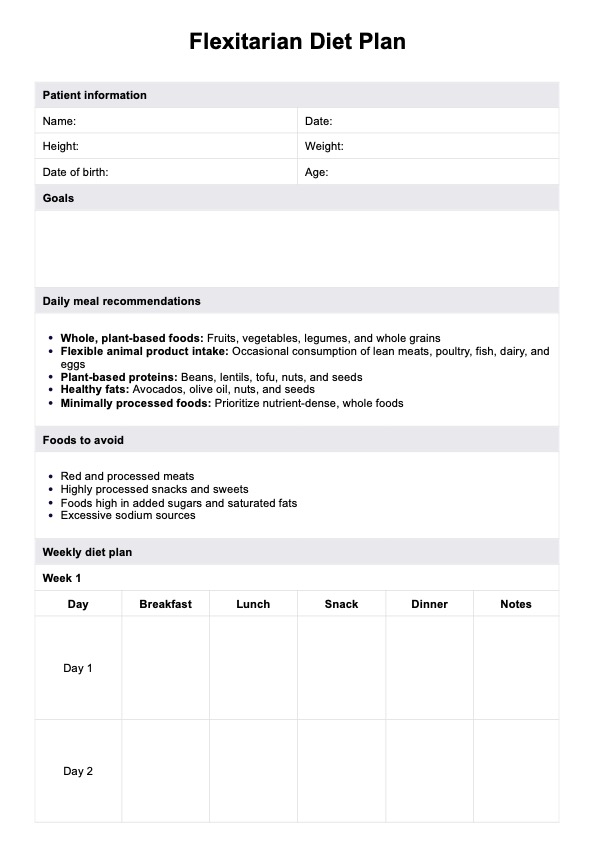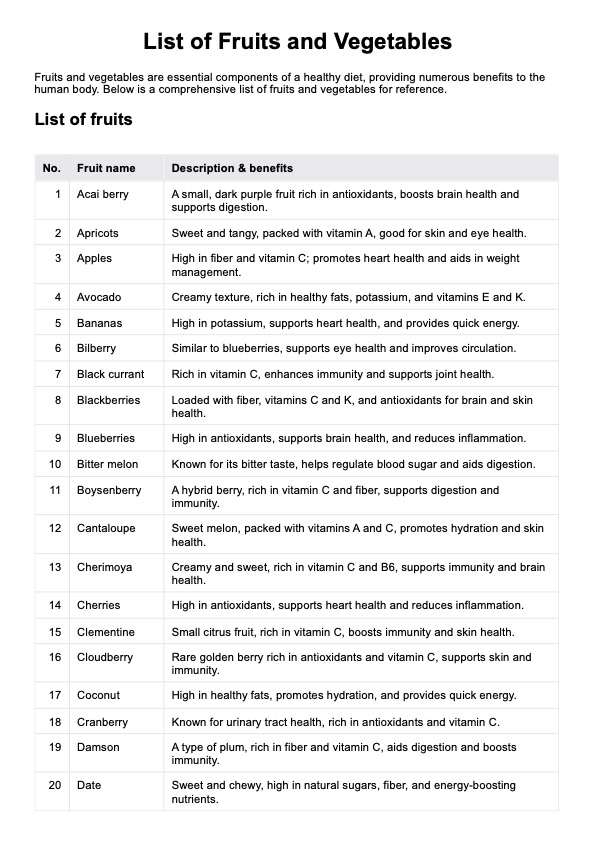Flexitarian Diet Food List
Provide your patient with a flexitarian diet food list when they express interest in trying said diet. Click here for a template to use during consultation.


What is a flexitarian diet?
A flexitarian diet is a flexible approach to eating that focuses on incorporating more plant-based foods while still allowing for the occasional consumption of meat and animal products. It is essentially a combination of a vegetarian diet and a regular omnivorous diet, making it a more achievable option for those hesitant about committing to a fully vegan or vegetarian lifestyle.
The key to a successful flexitarian diet plan is choosing the right foods. Here is a list of some of the most commonly recommended plant-based and animal products to include in a flexitarian diet:
- Plant-based foods: vegetables, fruits, whole grains, legumes (beans, lentils, peas), nuts and seeds.
- Animal products: lean meats such as chicken and fish, dairy products like milk and yogurt, and eggs.
However, it is essential to note that the amount of animal products consumed in a flexitarian diet should be significantly less than in a typical omnivorous diet. The focus should be on increasing plant-based foods and decreasing meat consumption.
Why Choose a flexitarian diet?
One might follow a flexitarian diet for many reasons, including health benefits and weight loss. Studies have shown that reducing meat consumption and incorporating more plant-based foods can lower the risk of chronic diseases such as heart disease, diabetes, and certain types of cancer (Derbyshire, 2017; Forestell, 2018; International Food Information Council Foundation, n.d).
Additionally, a flexitarian diet may help with weight loss due to the emphasis on healthy whole foods and decreased intake of highly processed foods. Focusing on nutrient-dense options, such as whole grains and healthy fats, while limiting unhealthy fats and highly processed foods makes it easier to stay within a calorie deficit and lose weight.
In addition to personal health benefits, a flexitarian diet can positively impact the environment. Animal agriculture is responsible for a significant portion of greenhouse gas emissions, and by reducing the consumption of animal products, individuals can help reduce their carbon footprint (Wolfson, 2019).
Check out our free Flexitarian Diet Food List for a healthier lifestyle
Flexitarian Diet Food List Template
Flexitarian Diet Food List Example
How does it work?
Step 1. Obtain the template
To obtain a digital and printable flexitarian diet food list as required, you can follow these steps:
- Choose either the "Download Template" or "Use Template" option.
- Employ the search function within Carepatron's template library, whether on the website or app, by entering "Flexitarian Diet Food List" as your search query.
Step 2. Read the content
The primary purpose of this chart is to serve as a valuable reference for individuals seeking information regarding permissible foods and foods to limit in a flexitarian diet.
Step 3. Create your meal plan
Feel free to brainstorm a meal plan with your client, utilizing the template as a resource, and write initial dish ideas in the notes area at the list of foods.
Alternatively, you are free to write down your meal plan on a separate sheet that you can store and access on Carepatron, a software where you can store electronic patient records. Carepatron adheres to HIPAA-compliant standards, so you're assured of the privacy and safety of details discussed during your consultation.
When would you use this list?
The Flexitarian Diet is a dietary approach that combines the flexibility of omnivorous eating while benefitting from having a predominantly plant-based lifestyle. The flexitarian diet and its corresponding food list is a choice to consider in multiple situations like the following:
Transitioning to a more plant-based diet
If your client is contemplating a dietary shift towards a more plant-based lifestyle but hesitates to eliminate meat, the Flexitarian Diet offers a suitable compromise. It includes occasional animal products while encouraging plant-based foods at every meal. This promotes better health through increased consumption of fruits, vegetables, and whole grains.
Bridging the gap for meat lovers
For individuals who have considered a vegetarian diet but were deterred by their love for dishes like burgers, steak, or fried chicken, the Flexitarian Diet provides a practical solution. It permits occasional meat consumption, allowing individuals to enjoy their favorite dishes while incorporating more plant-based options into their routine.
Enhancing nutritional choices
The Flexitarian Diet is designed for anyone seeking a more nutritious diet without entirely forgoing their preferred meat-based treats. It encourages a gradual reduction in meat consumption by initially omitting meat a few days a week and thoughtfully distributing meat intake over the remaining five days.
Health benefits
The Flexitarian Diet offers a range of health benefits, including a lowered risk of insulin resistance and type 2 diabetes, improved heart health by reducing high blood pressure and heart disease risk, enhanced digestion due to higher fiber content, and better cardiovascular health by reducing saturated fat intake. Moreover, it can help reduce inflammation and lower the risk of chronic diseases such as heart disease, diabetes, and cancer.
Do note, however, that your client should consult with a registered dietician first, if you're not one, before embarking on a new diet plan, especially if they have underlying health conditions. Furthermore, they should constantly update you on any negative physical symptoms they feel throughout their journey so you or their registered dietician can intervene immediately.
Research & evidence
The Flexitarian Diet has garnered attention in nutrition, and several studies and articles have explored its potential health benefits. Here's a summary of three studies/articles and their findings on the benefits of following the diet and utilizing a diet food list:
- According to an article entitled “Flexitarian Diets and Health: A Review of the Evidence-Based Literature" that reviewed over 25 studies, there's emerging evidence that following a flexitarian or semi-vegetarian diet may benefit one's body weight/metabolic health/blood pressure, reduce one's risk of type 2 diabetes, and may play a role in treating inflammatory bowel diseases.
- Research that involved over 10.000 individuals published in US News Health shows that the flexitarian diet can help enhance one's overall health and well-being, specifically reducing the risk of inflammation and developing heart disease and preventing type 2 diabetes, among others.
- Scientific research cited in the "What is a flexitarian diet?" article on BBC Good Food also indicated that a flexitarian diet, combined with physical activity, can reduce the risk of prostate and breast cancer.
Do note that even with all these studies, a healthcare practitioner is still encouraged to inform patients about the potential risks associated with the diet and to consider the patient's medical history, dietary needs, and lifestyle to further personalize a flexitarian diet food list.
References
Derbyshire, E. (2017). Flexitarian Diets and Health: A Review of the Evidence-Based Literature. Frontiers in Nutrition, 3. https://doi.org/10.3389/fnut.2016.00055
Dietitian, E. D. –. (2022, May 17). What is a flexitarian diet? BBC Good Food. https://www.bbcgoodfood.com/howto/guide/what-flexitarian-diet
The Flexitarian Diet Health and Nutrition. (n.d.). https://health.usnews.com/best-diet/flexitarian-diet/health-nutrition
Forestell, C. A. (2018). Flexitarian Diet and Weight Control: Healthy or Risky Eating Behavior? Frontiers in Nutrition, 5, Article 59. https://doi.org/10.3389/fnut.2018.00059
International Food Information Council Foundation. (n.d.). What Is the Flexitarian Diet? FoodInsight. Retrieved from https://foodinsight.org/what-is-the-flexitarian-diet/
Wolfson, S. (2019, January 19). Could flexitarianism save the planet? The Guardian. https://www.theguardian.com/environment/2019/jan/19/could-flexitarianism-save-the-planet
Commonly asked questions
Flexitarians primarily consume plant-based foods such as fruits, vegetables, whole grains, nuts, seeds, legumes, and healthy fats like olive oil. They also incorporate small amounts of animal products such as eggs and dairy into their diet and may occasionally eat meat or fish in smaller portions.
Individuals of all ages can follow the flexitarian diet, as it is flexible and customizable based on personal preferences and dietary requirements. However, it is always recommended to consult with a healthcare professional before making significant changes to your diet.
Plant-based and flexitarian diets share similarities, as they both emphasize consuming predominantly plant-based foods. However, a plant-based meal typically eliminates all animal products, while a flexitarian diet meal allows for occasional consumption in smaller portions.













































































































